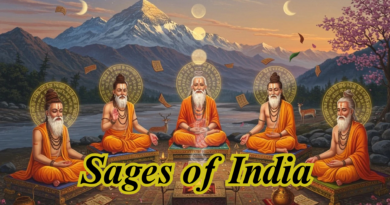SANATANA DHARMA AND NATURE: WHY TREES, RIVERS, AND ANIMALS ARE SACRED
Sanatana Dharma, often called the “eternal way of life,” is one of the oldest spiritual traditions in the world. It is not only about worship, rituals, or philosophy but also about the deep connection between humans and nature. According to Sanatana Dharma, all living and non-living beings are part of the same divine creation. The entire universe is seen as one family – “Vasudhaiva Kutumbakam,” meaning the world is one family.
This belief makes nature sacred. Trees, rivers, animals, mountains, and even the smallest plants or insects are respected as expressions of the divine. Let us explore why nature holds such a special place in Sanatana Dharma and why trees, rivers, and animals are treated as sacred.
The Sacredness of Trees
In Sanatana Dharma, trees are considered living beings with a soul. They are seen as providers of life because they give oxygen, fruits, shade, and wood, and they also help balance the environment. Ancient texts like the Vedas and Puranas describe trees as forms of gods or as abodes of divine energy.
The Peepal Tree (Ashvattha) is highly respected. It is said to be the tree where Lord Krishna resides. People believe that by worshipping the Peepal, one is honoring Lord Vishnu.
The Banyan Tree (Vat Vriksha) symbolizes immortality and stability. It is associated with Lord Shiva and Goddess Parvati.
The Tulsi Plant (Holy Basil) is worshipped in many Hindu households. It is considered sacred to Lord Vishnu and is also known for its healing properties.
The act of planting trees is seen as a great virtue in Sanatana Dharma. Ancient kings and saints encouraged people to grow trees along rivers, roads, and villages. Even today, many rituals include planting saplings as a way of serving both the earth and the divine.
Rivers: The Lifelines and Goddesses
Rivers in India are not just water bodies but divine mothers. They are worshipped as goddesses because they nurture life, provide food, and cleanse the body and soul. In Sanatana Dharma, water itself is sacred, but rivers hold a special place because they flow continuously, symbolizing purity and generosity.
Ganga (Ganges) is considered the holiest river. It is believed to have come from heaven to earth to purify humanity. Bathing in the Ganga is said to wash away sins and grant spiritual liberation.
Yamuna is linked with Lord Krishna’s childhood and is worshipped for its divine energy.
Saraswati, though now invisible, is considered the river of knowledge and wisdom.
Other rivers like Godavari, Narmada, and Kaveri are also worshipped with festivals and rituals.
Rivers are treated as mothers because they sustain civilizations. Many important cities, temples, and festivals have grown around rivers. By respecting rivers, Sanatana Dharma teaches us to protect water sources and never misuse them.
Animals: Companions in the Divine Plan
Animals, too, are sacred in Sanatana Dharma because they are seen as co-travelers in the cycle of life. Each species has its role in maintaining balance in nature, and many are connected with gods and goddesses.
The Cow is called “Gau Mata” (Mother Cow). She is respected as a symbol of nourishment, giving milk for humans and playing an important role in farming.
The Snake is linked with Lord Shiva, who wears it around his neck, representing control over fear and death.
The Elephant is sacred because of Lord Ganesha, the remover of obstacles, who has an elephant head.
The Lion is associated with Goddess Durga as her powerful vehicle.
The Monkey is honored through Lord Hanuman, known for devotion and strength.
Beyond symbolic associations, Sanatana Dharma teaches compassion toward all creatures. The principle of Ahimsa (non-violence) extends to animals, reminding us not to harm them unnecessarily.
Nature as the Divine Manifestation
Sanatana Dharma does not separate God from nature. Instead, it teaches that divinity exists in everything – the sun, moon, earth, fire, water, and air. The Pancha Mahabhutas (five great elements) – earth, water, fire, air, and space – are seen as the building blocks of life and are often worshipped directly.
This view helps people realize that by harming nature, we are harming ourselves and disrespecting the divine. It creates a sense of responsibility to live in harmony with the environment.
Modern Lessons from Ancient Wisdom
In today’s world, where deforestation, pollution, and climate change are major problems, the teachings of Sanatana Dharma are more important than ever. Planting trees, saving rivers, and protecting animals are not only spiritual duties but also practical steps for survival.
Festivals like Van Mahotsav (tree-planting festival) and rituals near rivers remind people of their responsibility toward nature. Even daily practices, like offering water to the sun (Surya Arghya) or feeding birds and cows, are ways to stay connected with the environment.
Conclusion
Sanatana Dharma shows us that nature is not just a resource to be used but a sacred reality to be respected. Trees are givers of life, rivers are divine mothers, and animals are our companions in the journey of existence. By treating them as sacred, Sanatana Dharma guides humanity to live in harmony with the natural world.
If modern society follows even a part of this wisdaom, it can bring balance back to the environment and help future generations live peacefully. Respecting nature is not only a religious act but also the highest form of gratitude to the universe.




